
The Siegrist's Mill Covered Bridge is an 88-foot (27 m), Burr Arch Truss covered bridge over Chiques Creek between Rapho and West Hempfield townships, Lancaster County in U.S. state of Pennsylvania. Owned and maintained by the county, its official designation is the Big Chiques #6 Bridge.

The Fort Madison Toll Bridge is a tolled, double-decked swinging truss bridge over the Mississippi River that connects Fort Madison, Iowa, and unincorporated Niota, Illinois. A double-track railway occupies the lower deck of the bridge, while two lanes of road traffic are carried on the upper deck. The bridge is about 1 mile (1.6 km) long with a swing span of 525 feet (160 m), and was the longest and largest double-deck swing-span bridge in the world when constructed in 1927. It replaced an inadequate combination roadway/single-track bridge completed in 1887. The main river crossing consists of four 270-foot (82 m) Baltimore through truss spans and a swing span made of two equal arms, 266 feet (81 m) long. In 1999, it was listed in the National Register of Historic Places under the title, Fort Madison Bridge, ID number 99001035. It was also documented as survey number IA-62 by the Historic American Engineering Record, archived at the Library of Congress. Construction and photographic details were recorded at the time in Scientific American magazine.

The Government Bridge or Arsenal Bridge spans the Mississippi River, connecting Rock Island, Illinois and Davenport, Iowa. The Iowa Interstate Railroad uses the upper deck of the bridge for its ex-Chicago and Rock Island Railroad route between Council Bluffs, Iowa and Chicago, Illinois. The lower deck carries automobile traffic between the two cities. It is located near Upper Mississippi Mile Marker 483, adjacent to the Mississippi River Lock and Dam No. 15. The current structure is the fourth at this location. The bridges all were built with a swing section to accommodate traffic navigating the river.

Lone Star is a wooden hull, steam-powered stern-wheeled towboat in LeClaire, Iowa, United States. She is dry docked and on display at the Buffalo Bill Museum in LeClaire. Built in 1868, she is the oldest of three surviving steam-powered towboats, and the only one with a wooden hull. She was declared a National Historic Landmark on 20 December 1989.

The County Farm Bridge is a historic stone arch bridge in Wilton, New Hampshire. Built in 1885, it carries Old County Farm over Whiting Brook, just south of its northern junction with Burton Highway in a rural section of northwestern Wilton. It is an unusually late and well-preserved example of a 19th-century stone arch bridge, and was listed on the National Register of Historic Places in 1981.
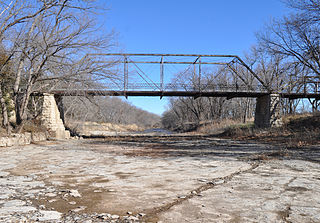
The Little Walnut River Pratt Truss Bridge is a Pratt truss bridge constructed shortly after 1885, in Bois d'Arc, Kansas. It was constructed by the Kansas City Bridge and Iron Company as a carriage, horse and pedestrian bridge over the Little Hickory Creek, which joins the Walnut River in southern Butler County. It was added to the National Register of Historic Places in 2003.
The Le Grand Bridge was a bridge north of Le Grand, Iowa, United States. It spanned the Iowa River for 242 feet (74 m), carrying traffic on a gravel road named Abbot Avenue. Since Abbott Avenue is the border between Marshall and Tama counties, the bridge is in two counties lengthwise. Many bridges span from one county to another, but few are lengthwise split. It necessitated a joint session of the two counties' Boards of Supervisors on June 29, 1896, to approve the project. The pinned Pratt through truss bridge was built in 1896 by the Marshalltown Bridge and Iron Works for $3,548. It was listed on the National Register of Historic Places in 1998. The bridge collapsed in the Iowa flood of 2008.

The Frantz Round Barn is a historic building that was located near Grand Junction in rural Greene County, Iowa, United States. It was built by Beecher Lamb in 1911. The true round barn measured 55 feet (17 m) in diameter. The barn was constructed in concrete block from Mid-Iowa Concrete of Grand Junction. It featured a 56-foot (17 m) tall central silo that was 16-foot (4.9 m) in diameter. The interior had a circular around the central silo on the first floor. The second floor had stalls for 12-14 horses, a circular, haymow, and granary. The barn was listed on the National Register of Historic Places since 1986. It has subsequently been torn down.
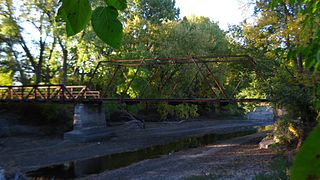
The Skunk River Bridge is a Warren truss bridge that crosses Skunk River near Ames, Iowa in Story County, Iowa. It was built in 1876, and was added to the National Register of Historic Places in 1998.
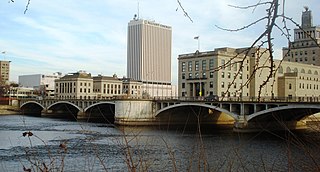
The First Avenue Bridge is a historic structure located in downtown Cedar Rapids, Iowa, United States. It carries U.S. Route 151 for 697 feet (212 m) over the Cedar River. The original six-span concrete arch structure was completed in 1920 for $420,000. It was designed by Marsh Engineering Company and built by Koss Construction Co., both of Des Moines. Consulting engineer Ned L. Ashton of Iowa City designed the 1960s remodel. He had all of the concrete work above the original arches torn out and the bridge rebuilt as an open-spandrel structure. The rebuild also included a wider deck to accommodate increased traffic and aluminum railings. While the bridge's original structural integrity has been compromised, this is the first notable concrete spandrel arch reconstruction in Iowa and possibly in the country. The bridge was listed on the National Register of Historic Places in 1998.

The River Street Bridge over the Iowa River at Iowa Falls, Iowa is an open spandrel bridge built during 1922–1924. It was built by the Weldon Brothers at cost of $16,900, including removal of the previous bridge on the site. It is the fourth bridge constructed on the site, a "pivotal" location in Iowa Falls' development. It has a long span, 140 feet (43 m), and is built with three side-by-side arched ribs supporting concrete pillars.
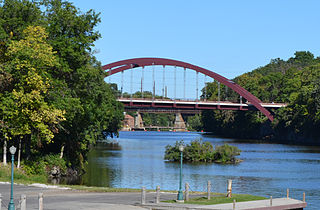
The Iowa Falls Bridge, also known as the Oak Street Bridge, was a historic structure located in Iowa Falls, Iowa, United States. The span carried U.S. Route 65 over the Iowa River for 255 feet (78 m). The through arch bridge was built by the Weldon Brothers Construction Co. of Iowa Falls in 1928 for $51,374.98. At the time it was completed the bridge was the longest arch span in the state of Iowa. It was listed on the National Register of Historic Places in 1998. The historic bridge was demolished and replaced in 2010.
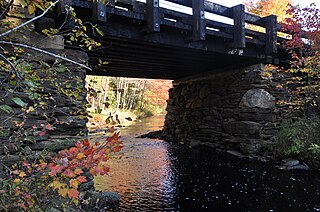
The Grist Mill Bridge is a historic bridge in Lebanon, Maine, carrying Little River Road across the Little River. Although the bridge has a 20th-century wooden deck on rubblestone abutments and pier, it is functionally similar to the bridge's original deck, which was also a wooden structure that may have existed as early as 1774. The bridge was listed on the National Register of Historic Places as a rare example of a bridge in the state with some essential 18th-century elements intact.

The Cascade Bridge is a historic structure located in Burlington, Iowa, United States. In April 1896 the Burlington City Council approved a proposal to have city engineer S.D. Eaton advertise for plans and estimates for a bridge on Main Street that would span Cascade Ravine. The Cascade Lumber Company had petitioned for the bridge. The city contracted with the Cedar Rapids, Iowa firm of Boynton & Warriner to design the structure and the Milwaukee Bridge and Iron Works to erect the span. The city was responsible for building the concrete substructure. The bridge was completed in the fall of 1896, and is composed of four spans. The span length is 160 feet (49 m), and its total length is 464 feet (141 m). The span is a Baltimore deck truss bridge with Pratt deck trusses at both ends. The structure is supported by stone and concrete abutments with concrete pedestals and a single concrete-filled steel cylinder pier. Over the years the original deck has been replaced, and concrete has been applied to the stone abutments. Otherwise the structure has been unaltered. The bridge was listed on the National Register of Historic Places in 1998.

Nodaway River Bridge is located west of Grant, Iowa, United States. It spans an arm of a small pond in Pilot Grove County Park for 70 feet (21 m). The Montgomery County Board of Supervisors accepted a petition from S. M. Smith to build a bridge over the Nodaway River south of Grant in June 1876, and another bridge over the Nishnabotna River at the same time. The county contracted with the Missouri Valley Bridge & Iron Co. of Leavenworth, Kansas, to design and build the Nodaway River bridge, which was completed later the same year for $1,000. The bridge consists of a single-span Bowstring arch-truss with a wood deck. It remained in use as a road bridge until 1968, when it was moved to the park for use as a pedestrian bridge. Even though it is no longer in its historic location and used for its historic function, the bridge was listed on the National Register of Historic Places in 1998 as an example of early transportation development in Iowa.
The Chicago, Rock Island and Pacific Railroad Stone Arch Viaduct, also known as the Old Stone Arch, is located northeast of Shelby, Iowa, United States. The span carried the Chicago, Rock Island and Pacific Railroad tracks over Little Silver Creek. It measures 35 feet (11 m) from the water level to the deck, 20 feet (6.1 m) in width, and 30 feet (9.1 m) in length. The bridge has flanking wingwalls that measure 40 feet (12 m) in length. Limestone for the bridge was quarried near Earlham, Iowa and transported by train to the site. It is one of two such bridges known to exist in Shelby County. The Rock Island was the first railroad to enter the county, and continued to operate here into the 1950s. At that time they abandoned the line when the Atlantic cutoff was built providing a more direct route between Atlantic, Iowa and Council Bluffs. While the tracks were removed, the stone arch, the railroad grade, and the right-of-way were left intact. They are now part of the Rock Island Old Stone Arch Nature Trail. The bridge was listed on the National Register of Historic Places in 1998.
The Upper Bluffton Bridge was a historic structure located in Bluffton, Iowa, United States. It spanned the Upper Iowa River for 154 feet (47 m). This bridge was designed, fabricated and built by the Wrought Iron Bridge Company of Canton, Ohio for $2,831.23. This and the Lawrence Bridge were built at the same time, and it marked the first time that Winneshiek County had longer-span trusses built at rural river crossings instead of the smaller bowstring truss bridges. This bridge was listed on the National Register of Historic Places in 1998. It was closed to traffic because of structural problems, and replaced in 2011. Plans at that time were to move the structure to the Millgrove Access Wildlife Area in Poweshiek County, Iowa. However, the move was not made and the structure was replaced with some parts of the original structure being repurposed on a bridge on the Trout Run Bike Trail around Decorah. A plaque was placed adjacent to the new structure in Bluffton commemorating the original structure.
The Burlington Railroad Overpass is a historic structure northwest of Chariton, Iowa, United States. It spans the BNSF Railway tracks for 322 feet (98 m). The Iowa State Highway Commission (ISHC) designed several steel deck arch bridges in the 1930s to replace grade railroad crossings. The three-hinge arch is supported by concrete arch pedestals and was designed to cross the Chicago, Burlington and Quincy Railroad tracks. ISHC contracted with Ben Cole and Son of Ames, Iowa in 1936 to build the structure, which was completed a year later. The roadway has been widened, and guardrails have been replaced in subsequent years. It is the only example of this bridge type left in the state. It was listed on the National Register of Historic Places in 1998.
The Garnavillo Township Bridge is a historic structure located west of Garnavillo, Iowa, United States. It spans an unnamed stream for 20 feet (6.1 m). Around the turn of the 20th-century Clayton County embarked on a project to replace its old bridges. On short crossing like this one they generally chose simple timber stringer structures. But for this one, and several others, they chose to take advantage of the large limestone deposits in the county. They contracted with stonemason A.C. Boyle of McGregor, Iowa to build this single deck arch bridge for $1,462.72. It replaced an old combination truss span. This bridge also been replaced, but it remains in place underneath the newer bridge. It was listed on the National Register of Historic Places in 1998.

The Herrold Bridge is a historic structure located near the unincorporated community of Herrold, Iowa, United States. It carried a gravel road for 156 feet (48 m) over Beaver Creek. Completed in 1921, this concrete cantilevered deck girder bridge replaced an earlier timber pile structure. It was designed by the Iowa State Highway Commission the previous year, and the Polk County Board of Supervisors awarded the construction contract to Ben Cole of Ames. The total cost of construction was $24,283.36. The bridge features three arched concrete deck girder spans that are cantilevered from concrete abutments and piers. It is considered one of the most technologically significant of Iowa's concrete girder bridges. The bridge was listed on the National Register of Historic Places in 1998. While it remains in place, the Herrold Bridge was replaced by a newer span slightly downstream.





















